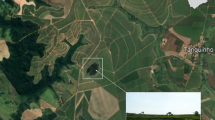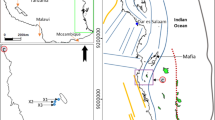Abstract
A combination of vertical electrical soundings (VES), 2D electrical resistivity imaging (ERI) surveys and borehole logs were conducted at Magodo, Government Reserve Area (GRA) Phase 1, Isheri, Southwestern Nigeria, with the aim of delineating the different aquifers present and assessing the groundwater safety in the area. The Schlumberger electrode array was adopted for the VES and dipole-dipole array was used for the 2D imaging. The maximum current electrode spread (AB) was 800 m and the 2D traverse range between 280 and 350 m in the east-west direction. The thickness of impermeable layer overlying the confined aquifer was used for the vulnerability ratings of the study area. Five lithological units were delineated: the topsoil, clayey sand, unconsolidated sand which is the first aquifer, a clay stratum and the sand layer that constitutes the confined aquifer horizon. The topsoil thickness varies from 0.6 to 2.6 m, while its resistivity values vary between 55.4 and 510.6 Ω/m. The clayey sand layers have resistivity values ranging from 104.2 to 143.9 Ω/m with thickness varying between 0.6 and 14.7 m. The resistivity values of the upper sandy layer range from 120.7 to 2195.2 Ω/m and thickness varies from 3.3 to 94.0 m. The resistivity of the clay layer varies from 11.3 to 96.1 Ω/m and the thickness ranges from 29.6 to 76.1 m. The resistivity value of the confined aquifer ranges between 223 and 1197.4 Ω/m. The longitudinal conductance (0.0017–0.02 mhos) assessment of the topsoil shows that the topsoil within the study area has poor overburden protective capacity, and the compacted impermeable clay layer shows that the underlying confined aquifer is well protected from contamination and can be utilized as a source of portable groundwater in the study area. This study therefore enabled the delineation of shallow aquifers, the variation of their thicknesses and presented a basis for safety assessment of groundwater potential zones in the study area.











Similar content being viewed by others
References
Abdulaziz MA (2005) Resistivity methods for groundwater exploration in the cretaceous-tertiary sedimentary sequence, east of Jeddah, Saudi Arabia. J Environ Hydrol 13(19):1–11
Abiola O, Enikanselu PA, Oladapo MI (2009) Groundwater potential and aquifer protective capacity of overburden units in ado-Ekiti, southwestern Nigeria. International Journal of Physical Sciences 4(3):120–132
Akintola JO (1986) Rainfall distribution in Nigeria 1982–1983. Impact Publishers Nigeria Limited, Ibadan, p 371
Ako BD, Osondu VC (1986) Electrical resistivity of the Kerri-Kerri Formation, Darazo, Nigeria. J Afr Earth Sci 5(5):527–534
Ako BD, Ajayi TR, Arubayi JB, Enu EI (2005) The groundwater and its occurrence in the coastal plains sands and alluvial deposits of parts of Lagos State. Nigeria Water Resources 16:7–17
Anomohanran O (2013) Geoelectrical investigation of groundwater condition in Oleh, Nigeria. www.arpapress.com. IJRRAS 15(1): 1–5
Bhattacharya APK, Patra HP (1968) Direct current geoelectric sounding: principles and interpretations. Methods of Geochemistry and Geophysics 9(1):133
Chukwuma EC, Orakwe LC, Anizoba DC, Amaefule DO, Odoh CC, Nzediegwu C (2015) Geoelectric groundwater vulnerability assessment of overburden aquifers at Awka in Anambra State, South Eastern Nigeria. European journal of Biotechnology and Bioscience 3(1):29–34
Ekpo AE, Orakwe LC, Ekpo FE, Eyeneka FD (2016) Evaluating the protective capacity of aquifers at Uyo in Akwa Ibom state, southern Nigeria, using the vertical electrical sounding (VES) technique. IARJSET 3(1):34–39
Gebhardt H, Adekeye OA, Akande SO (2010) Late Paleocene to initial Eocene thermal maximum foraminiferabiostratigarphy and paleoecology of the Dahomey Basin, southwestern Nigeria. Gjahrbuch Der GeologischemBundesantalt. 150:407–419
Golam SS, Keramat M, Shahid M (2014) Deciphering transmissivity and hydraulic conductivity of the aquifer by vertical electrical sounding (VES) experiments in Northwest Bangladesh. Appl Water Sci
Hassanein H, El-Kaliouby H, Al-Garni MA (2007) The use of DC-resistivity to outline the subsurface hydrogeological and structural setting beneath a proposed site for subsurface DAM building, Makkah Al-Mukarramah, Saudi Arabia. Journal of King Abdul Aziz University: Earth Sciences 18(1):117–138
Kalinski RJ, Kelly WE, Bogard S (1993) Combined use of geoelectrical sounding and profiling to quantify aquifer protection properties. Groundwater. 31:538–544
Kelly EW (1976) Geoelctric sounding for delineating groundwater contamination. Groundwater 14:6–11
Lashkaripour GR, Sadeghi H, Qushaeei M (2005) Vertical electrical soundings for groundwater assessment in Southeastern Iran: a case study, J. Applied Geophy 5(1):973–977
Longe EO, Malomo S, Oloruniwo MA (1987) Hydrogeology of Lagos Metropolis. J Afr 6(2):163–174
Mbonu PD, Ebeneiro JO, Ofoegbu CO (1991) Geoelectric sounding for the determination of aquifer characteristics in parts of Umuahia area of Nigeria. SEG Geophysics 36(2):284–291
Mosuro GO, Omosanya KO, Bayewu OO, Oloruntola MO, Laniyan TA, Atobi O, Okubena M, Popoola E (2016) Assessment of groundwater vulnerability to leachate infiltration using electrical resistivity method. Appl Water Sci Springer
Odemerho FO, Onokerheraye AG (1994) Physical geography (handbook for the tropics). The Benin Social science series of Africa, University of Benin, Benin City Nigeria, 16–28, 70–71, 240–255
Okosun EA (1998) Review of the early tertiary stratigraphy of southwestern Nigeria. J of Mining and Geology 34:27–35
Oladapo MI, Akintorinwa OJ (2007) Hydrogeophysical study of Ogbese Southwestern, Nigeria. Global J Pure and Applied Sci 13(1):55–61
Oladapo MI, Muhammed NZ, Adeoye OO, Adetola BA (2004) Geoelectrical investigation of the Ondo state housing corporation estate, Ijapo, Akure, southwestern Nigeria. Journal of Mining Geology 20:412–480
Olatunji AS, Abimbola AF, Oloruntola MO, Odewande AA (2005) Hydrogeochemical evaluation of groundwater resources in shallow coastal aquifers around Ikorodu area, southwestern Nigeria. Water Resource 16:65–71
Olayinka AI, Olorunfemi MO (1992) Determination of geoelectric characteristics of Okene area and implication for boreholes siting. J Min Geol 28:403–412
Olorunfemi MO, Fasuyi SA (1993) Aquifer types, geoelectric and hydrogeologic characteristics of part of the Central Basement Terrain of Niger State Nigeria. J Afr Earth Sci 16(1):309–317
Olorunfemi MO, Ojo JS, Oladapo MI (1998) Geological hydrogeological and geophysical investigations of exposed 20″ Escravos Lagos Pipeline Technical Report
Omatsola ME and Adegoke OS (1981) Tectonic evolution and cretaceous stratigraphy of the Dahomey Basin. J Min Geol. p 130–137
Omosuyi GO, (2001). “Geophysical and Hydrogeological Investigations of Ground water Prospects in the Southern part of Ondo State, Nigeria”. Ph.D. Thesis, Department of Applied Geophysics, Federal University of Technology, Akure, Nigeria. 195
Omosuyi GO, Ojo JS, Olorunfemi MO (1999) Borehole lithologic correlation and aquifer delineation in parts of the Coastal Basin of SW Nigeria. J Appl Sci 2:617–626
Rădulescu V, Rădulescu F, Stan L (2006) Geoelectrical measurements applied to the assessment of groundwater quality. GEO-ECO-MARINA
Reynolds JM (1997) An introduction to applied and environmental geophysics. Wiley, Chichester, p 778
Sørensen KI, Auken E, Christensen NB, Pellerin L (2005) An integrated approach for hydrogeophysical investigations: new technologies and a case history. In: Butler DK (ed) Near-Surface Geophysics 2, Investigations in Geophysics, 13. Society of Exploration Geophysics, 585–603
Telford WM, Geldart LP, Sheriff RE (1990) Applied geophysics. Cambridge University Press, Cambridge, p 770
Author information
Authors and Affiliations
Corresponding author
Rights and permissions
About this article
Cite this article
Oloruntola, M.O., Bayewu, O.O., Mosuro, G.O. et al. Groundwater occurrence and aquifer vulnerability assessment of Magodo Area, Lagos, Southwestern Nigeria. Arab J Geosci 10, 110 (2017). https://doi.org/10.1007/s12517-017-2914-3
Received:
Accepted:
Published:
DOI: https://doi.org/10.1007/s12517-017-2914-3




